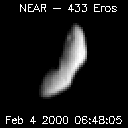The Minor Planets
 Asteroids are rocky fragments left over from the formation of the solar system about 4.6 billion years ago. Most of these fragments of ancient space rubble - sometimes referred to by scientists as minor planets - can be found orbiting the Sun in a belt between Mars and Jupiter. This region in our solar system, called the Asteroid Belt or Main Belt, probably contains millions of asteroids ranging widely in size from Ceres, which at 940 km in diameter is about one-quarter the diameter of our Moon, to bodies that are less than 1 km across. There are more than 20,000 numbered asteroids.
Asteroids are rocky fragments left over from the formation of the solar system about 4.6 billion years ago. Most of these fragments of ancient space rubble - sometimes referred to by scientists as minor planets - can be found orbiting the Sun in a belt between Mars and Jupiter. This region in our solar system, called the Asteroid Belt or Main Belt, probably contains millions of asteroids ranging widely in size from Ceres, which at 940 km in diameter is about one-quarter the diameter of our Moon, to bodies that are less than 1 km across. There are more than 20,000 numbered asteroids.
As asteroids revolve around the Sun in elliptical orbits, giant Jupiter's gravity and occasional close encounters with Mars or with another asteroid change the asteroids' orbits, knocking them out of the Main Belt and hurling them into space across the orbits of the planets. For example, Mars' moons Phobos and Deimos may be captured asteroids. Scientists believe that stray asteroids or fragments of asteroids have slammed into Earth in the past, playing a major role both in altering the geological history of our planet and in the evolution of life on it. The extinction of the dinosaurs 65 million years ago has been linked to a devastating impact near the Yucatan peninsula in Mexico.
NASA's Near-Earth Asteroid Rendezvous (NEAR) mission was the first dedicated scientific mission to an asteroid. The NEAR Shoemaker spacecraft caught up with asteroid Eros in February 2000 and orbited the small body for a year, studying its surface, orbit, mass, composition, and magnetic field. In February 2001, mission controllers guided the spacecraft to the first-ever landing on an asteroid.
Fact Credit
NASA Office of Space Science
Office of Space Science Web Site


